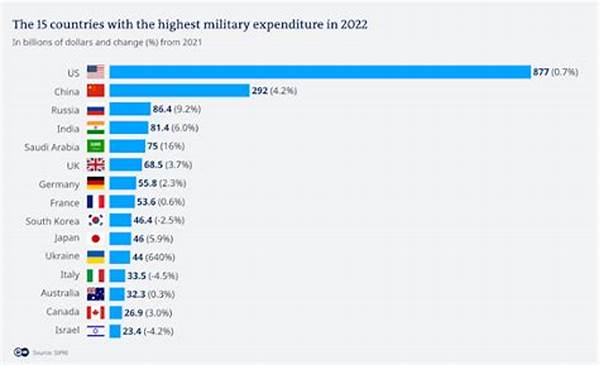Global Defense Expenditure Overview
The analysis of global defense spending trends reveals a dynamic allocation of resources influenced by geopolitical tensions and technological advancements. Over the past decade, numerous nations have increased their defense budgets, responding to perceived threats and regional conflicts. This escalation, largely seen in Asia and the Middle East, underscores the strategic importance of maintaining military capabilities in volatile environments. Nations such as China and India have emerged as major players, augmenting their defense spending considerably to bolster their military strength and ensure national security.
Simultaneously, traditional powerhouses like the United States and Russia continue to allocate substantial resources to defense, albeit with varying motivations and implications. For the U.S., sustaining global military presence and technological superiority remains paramount, while Russia’s focus is on reasserting its influence and addressing European security concerns. Furthermore, European nations, reacting to both external threats and internal pressures, have gradually increased their defense expenditures, demonstrating a collective commitment to NATO obligations and an enhanced defense posture.
In contrast, other regions exhibit a different pattern in defense spending. African and Latin American countries generally allocate fewer resources, concentrating on domestic priorities and regional cooperation. Consequently, the analysis of global defense spending trends reflects diverse strategic choices shaped by each nation’s unique geopolitical context and available resources.
Key Factors Influencing Defense Spending
1. Geopolitical Tensions: Analysis of global defense spending trends highlights that geopolitical tensions significantly drive expenditure increases, as nations aim to mitigate perceived threats.
2. Technological Advancements: Investments in cutting-edge technology are integral to maintaining military superiority, influencing defense budgets worldwide.
3. Regional Conflicts: Persistent regional conflicts necessitate increased defense budgets to ensure preparedness and safeguarding of national interests.
4. Economic Capacity: A country’s economic health directly impacts its ability to allocate funds to defense without undermining other crucial areas of development.
5. Alliance Commitments: International alliances compel member states to uphold agreed-upon defense spending levels, affecting national allocation decisions.
Defense Spending in Asia and the Middle East
In-depth analysis of global defense spending trends indicates significant growth in Asia and the Middle East. This surge is primarily driven by regional security dilemmas and power projection ambitions. For example, China’s defense investments are motivated by territorial claims and growing influence in the South China Sea. Similarly, India focuses on modernizing its military to counter perceived threats from neighboring countries and to assert its role as a regional power.
In the Middle East, countries facing ongoing conflicts and regional instability, such as Saudi Arabia and Israel, have prioritized defense spending to maintain security and stability. The procurement of advanced weaponry and collaborations with Western defense industries underscore the strategic imperatives driving their defense expenditures. Thus, the analysis of global defense spending trends in these regions reveals strategic investments aimed at navigating complex security landscapes and achieving regional objectives.
Comparative Analysis of Defense Budgets
1. The United States maintains the largest defense budget worldwide, driven by its commitment to global security and military dominance.
2. China’s defense spending is second only to the U.S., reflecting its ambitions to enhance military capabilities and regional influence.
3. Russia continues to prioritize defense spending to support its strategic objectives and maintain a competitive edge against NATO forces.
4. European Union member states, collectively, exhibit an upward trend in defense budgets, aligning with NATO commitments.
5. Middle Eastern nations allocate substantial resources to defense due to persistent regional conflicts and security challenges.
6. African nations typically allocate limited funds for defense, prioritizing economic and social development.
7. Latin American countries invest conservatively in defense, focusing on cooperation and economic stability.
8. India manifests one of the highest defense expenditures globally, driven by regional security dynamics and modernization efforts.
9. Japan remains committed to a robust defense posture amid regional security concerns in East Asia.
10. South Korea’s defense investments reflect its strategic priorities in countering threats from neighboring adversaries.
Europe’s Strategic Defense Adjustments
Recent analysis of global defense spending trends underscores Europe’s evolving defense landscape amid recent geopolitical challenges. The growing perception of threat from Russia has prompted several European nations to reassess their defense strategies. By increasing budget allocations, they aim to reinforce conventional and cyber capabilities, while enhancing interoperability within NATO frameworks.
Countries such as Germany, France, and the United Kingdom lead this transformation, emphasizing modernization and collaborative defense projects. Their investments also focus on maintaining technological parity with global powers, which is critical for ensuring long-term security. This strategic recalibration underscores Europe’s commitment to addressing external threats and contributing to global peace and stability through increased defense spending.
Implications for Global Security
The analysis of global defense spending trends presents essential insights into the implications for international security dynamics. Greater military expenditures by countries worldwide lead to a heightened state of alert and competition, potentially escalating regional arms races. As nations prioritize defense over other areas, diplomatic engagements may take a backseat, impacting conflict resolution efforts.
Nevertheless, increased defense investments also signify opportunities for enhanced security cooperation and alliance strengthening. By adopting a multilateral approach to defense spending, countries can foster an environment of collective security and mutual assurances. Consequently, the broader impact of global defense expenditure trends on global peace and stability hinges on how effectively nations balance military investments with diplomacy.
Conclusion
In conclusion, the analysis of global defense spending trends underscores the complex interplay of geopolitical factors influencing national budgets. Variations in spending reflect diverse regional priorities and security concerns, with countries strategically allocating resources to address perceived threats and assert influence. While high defense budgets can contribute to regional stability, they may also exacerbate tensions if not coupled with effective diplomatic communication and collaboration.
Long-term global security will depend on a balanced approach that considers both military and diplomatic strategies. The current landscape serves as a reminder of the continuing need for dialogue and cooperation in addressing shared challenges. As nations continue to navigate an evolving security environment, insightful analysis of global defense spending trends will remain vital in shaping future policies and strategic decisions.





